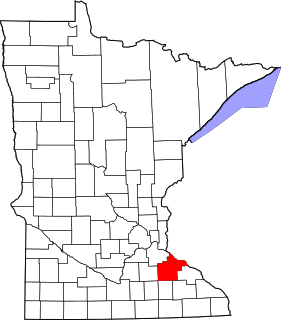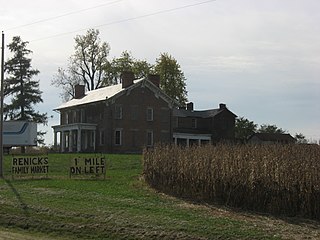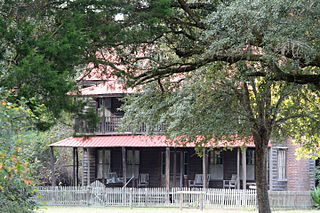
The Queens County Farm Museum, also known as Queens Farm, is a historic farm located on 47 acres (190,000 m2) of the neighborhoods of Floral Park and Glen Oaks in Queens, New York City. The farm occupies the city's largest remaining tract of undisturbed farmland, and is still a working farm today. The site features restored farm buildings from three different centuries, a greenhouse, planting fields, livestock, and various examples of vintage farm equipment. Queens Farm practices sustainable agriculture and has a four-season growing program.

Christian Iutzi Farm is a historic property near Trenton, Ohio.

The Farm House, also known as the Knapp–Wilson House, is the oldest building on the campus of Iowa State University in Ames, Iowa. Now a museum open to the general public, this house was built 1861-65 as part of the model farm that eventually became Iowa State. It was designated a National Historic Landmark in 1964 for its association with agriculturist and teacher Seaman A. Knapp and with U.S. Secretary of Agriculture James Wilson, both of whom lived here while teaching at Iowa State.

The Kennedy Farm is a National Historic Landmark property on Chestnut Grove Road in rural southern Washington County, Maryland. It is notable as the place where the radical abolitionist John Brown planned and began his raid on Harpers Ferry, Virginia, in 1859. Also known as the John Brown Raid Headquarters and Kennedy Farmhouse, the log, stone, and brick building has been restored to its appearance at the time of the raid. The farm is now owned by a preservation nonprofit.

This is a list of the National Register of Historic Places listings in Carver County, Minnesota. It is intended to be a complete list of the properties and districts on the National Register of Historic Places in Carver County, Minnesota, United States. The locations of National Register properties and districts for which the latitude and longitude coordinates are included below, may be seen in an online map.

This is a list of the National Register of Historic Places listings in Goodhue County, Minnesota. It is intended to be a complete list of the properties and districts on the National Register of Historic Places in Goodhue County, Minnesota, United States. The locations of National Register properties and districts for which the latitude and longitude coordinates are included below, may be seen in an online map.

This is a list of the National Register of Historic Places listings in Blue Earth County, Minnesota. It is intended to be a complete list of the properties and districts on the National Register of Historic Places in Blue Earth County, Minnesota, United States. The locations of National Register properties and districts for which the latitude and longitude coordinates are included below, may be seen in an online map.

The Renick Farm is a historic farmstead located along U.S. Route 23 near the village of South Bloomfield in northern Pickaway County, Ohio, United States. Composed of six buildings dating back to 1830, the farmstead has been designated a historic site because of its unusually well-preserved architecture.

The Boyd–Wilson Farm is a 157-acre (64 ha) historic district in Franklin, Tennessee, United States. The circa 1840 farm includes an I-house.

Cleburne Jersey Farm is a historic farmhouse in Spring Hill, Tennessee, USA.

Webster Farm is a historic farmhouse in Cross Bridges, Tennessee, USA.

The Oakham Farm is a historic farm at 23226 Oakham Farm Lane, near Middleburg in Loudoun County, Virginia. The farm includes 100 acres (40 ha) of land north of United States Route 50, with its building complex anchored by a farmhouse built in 1847 and repeatedly altered. The main portion of the farmhouse is a 1920s three-story Classical Revival block, which has the original 1847 two-story Greek Revival house attached as an ell to one side, along with another c. 1840 structure that may have functioned as a separate kitchen. The property was first developed by the Peyton family, with its present buildings dating to the ownership of the Rogers family. During the American Civil War, Oakham was where the irregular Confederate Army unit known as Mosby's Rangers was organized.

The William Anzi Nichols House is a historic residence located east of Winterset, Iowa, United States. Nichols bought an 80 acres (32 ha) farm in 1855 and owned the land until he died in 1867. This house is an early example of a vernacular limestone farmhouse. The 1½-story structure is composed of locally quarried finished cut and rubble limestone. Its construction is attributed to David Harris who was known for laying the stones in a two against one broken bond. The house was listed on the National Register of Historic Places in 1987.

The John and Fredericka Meyer Schnellbacher House is a historic residence located southwest of Winterset, Iowa, United States. The Schnellbachers were native Germans who settled in Madison County in 1855. He farmed 240 acres (97 ha), and was a preacher affiliated with the Evangelical Association of Ohio. This house is an early example of a vernacular limestone farmhouse. The 1½-story structure is composed of locally quarried stone that is almost ashlar finished and rubble. It features unique window and door surrounds on the main facade, a stone chimney, and an exposed basement. The house was listed on the National Register of Historic Places in 1987.

The Hiram C. Smith House is a historic residence located west of Winterset, Iowa, United States. Smith was one of the earliest settlers in this township, having acquired the deed to the 280-acre (110 ha) farm between 1854 and 1856. This house is an early example of a vernacular limestone farmhouse. It is a 1½-story, one-room structure composed of rubble stone quarried on the farm and laid in a random bond. Its construction is attributed to Smith, as its rough and simple construction do not reflect the work of any of the stonemasons working in the county at the time it was built. The house was listed on the National Register of Historic Places in 1987. His milking shed, built about the same time and on the same property, is also listed on the National Register.

The Evan F. Ellis Farmhouse is an historic residence located north of Bussey, Iowa, United States. Evan, his wife Bertha, and their two daughters moved from Illinois and settled on the 120-acre (49 ha) farm they bought in Marion County, Iowa in 1909. He built this Sears, Roebuck & Co. "Honor Bilt Modern Homes" pre-cut house in 1913. It was unusual for such a house to be built in a rural area because all the parts would have to be transported a longer distance. The two-story frame house features a full-length front porch, projecting wall dormers, and it is capped with a hipped roof. After Evan's (1949) and Bertha's (1959) deaths, their daughter Mary continued to live in the house and run the farm until her death in 1974. While the family continued to own the farm, the house was rented to tenants until 1983 when Bonnie Vanderlinden Noah, Evan and Bertha's granddaughter, and her husband Jack began restoring the house for them to live in. The house was listed on the National Register of Historic Places in 1985.

The Lairdland Farm House is a historic farmhouse in Giles County, Tennessee, U.S..

The Carstens Farmstead is a collection of historic buildings located south of Shelby, Iowa, United States. Johan Carstens was a German immigrant who spent eight years living and working in Milwaukee, Chicago, and Davenport, Iowa before settling in Pottawattamie County in 1871, where he established this farm. He bought 160 acres (65 ha) of land from the Chicago, Rock Island and Pacific Railroad, and continued to farm it until he and his wife retired in 1905. The farm remained in the Carstens family until 1977, when the last of the 80 acres (32 ha) was donated to the Pottawattamie County Historical Society. The farm buildings include: the original farmhouse (1872), the 1888 farmhouse with the summer kitchen, an outhouse, garage (1917), granary (1898), horse and dairy barn (1886), beef cattle barn (1903), beef cattle barn (1917), forge and workshop, windmill (1916), feed shed (1919), hog house (1919), poultry house, machine shed (1920), the cob house (1926), and a corn crib (1930). The buildings were listed together on the National Register of Historic Places in 1979.
Keener-Johnson Farm is a historic farmhouse in Seymour, Tennessee, U.S.. It was built circa 1853 for Adam Harvey Keener. It has been listed on the National Register of Historic Places since March 18, 1999.

The Reiser-Zoller Farm was listed on the National Register of Historic Places in 1989. The farm has a farmhouse complex consisting of a 1900-built two-story plantation-plain style building with a two-story front porch, linked to an original 1875-built one-story farmhouse. It has about a dozen outbuildings including three barns.


















